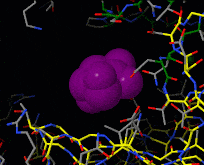Induced fit
From Proteopedia
(Difference between revisions)
(→Interactive examples) |
|||
| (2 intermediate revisions not shown.) | |||
| Line 11: | Line 11: | ||
<StructureSection load='' size='350' side='right' caption='' scene=''> | <StructureSection load='' size='350' side='right' caption='' scene=''> | ||
| - | This is a [[morphs|morph]] of the <scene name='31/318562/Hexokinase/ | + | This is a [[morphs|morph]] of the <scene name='31/318562/Hexokinase/3'>closed and open form of hexokinase</scene> (be patient when loading this). The first and the last frame of the animation are models based on crystallographic data while the intermediate states are somewhat arbitrary, but chosen to show a smooth transition between conformations. |
| + | <jmol> | ||
| + | <jmolRadioGroup> | ||
| + | <item> | ||
| + | <script>anim off;model 1</script> | ||
| + | <text>Open</text> | ||
| + | </item> | ||
| + | <item> | ||
| + | <script>anim off;model 11</script> | ||
| + | <text>Closed</text> | ||
| + | </item> | ||
| + | <item> | ||
| + | <script>anim on;</script> | ||
| + | <text>Animated</text> | ||
| + | <checked>true</checked> | ||
| + | </item> | ||
| + | </jmolRadioGroup> | ||
| + | </jmol> | ||
</StructureSection> | </StructureSection> | ||
Current revision
Induced fit describes a conformational change in a protein when it binds a ligand, in contrast to a lock-and-key model of ligand binding. A classic example of induced fit is binding of glucose to hexokinase, depicted in a morph between 3o8m and 3o80 in the picture at right.
Contents |
History of the concept
Induced fit was suggested by Koshland in 1958 [1], providing an alternative to the lock-and-key binding model that Emil Fischer proposed in 1899 [2].
Interactive examples
| |||||||||||
See Also
- A morph of induced fit when Tamiflu binds to Neuraminidase.

